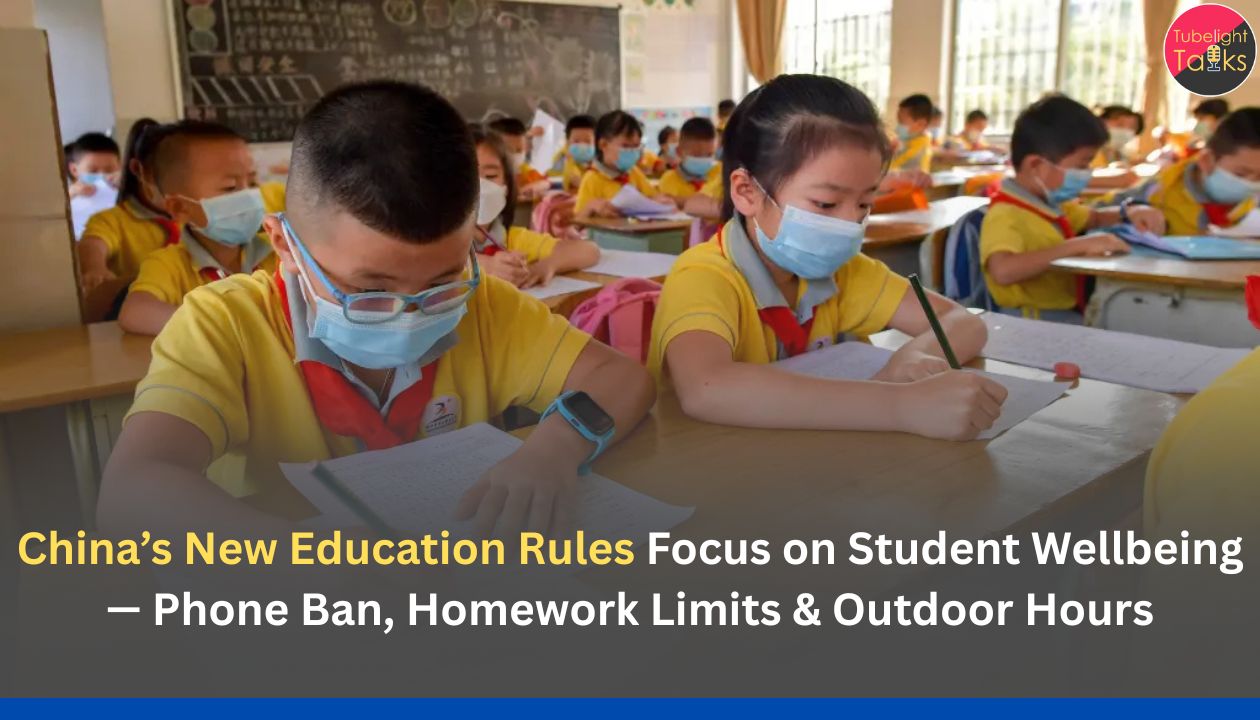China’s New Education Rules: China’s Ministry of Education (MOE) continues to tighten its landmark 2021 “Double Reduction” policy with fresh provincial roll-outs in 2025. The goal: slash academic pressure, curb digital overload, and boost physical health.
Key measures now being strictly enforced nationwide:
- Classroom mobile-phone bans
- Homework volume caps
- 1 hour of PE + 1 hour of outdoor activity every school day
- Reduced exam frequency
This article breaks down the challenges, and actionable tips for parents, teachers, and ed-tech firms.
Why now? The rise of student stress and digital pressure
Over the past decade China has grappled with skyrocketing academic competition, longer study hours and rising concerns about student wellbeing. The pandemic years increased screen use for learning and leisure — and that trend has persisted.
Research links excessive screen time with poorer sleep, increased anxiety and reduced physical activity among children and adolescents. In response, Beijing’s recent policy push targets multiple drivers of stress at once: digital overload, relentless homework, and insufficient exercise.
Why Now? The Backdrop of Academic Pressure
- Gaokao competition drives 12–14-hour study days in many cities.
- Pandemic-era screen surge never fully reversed.
- Myopia rates: ~80% among urban teens (Chinese Journal of Ophthalmology, 2023).
- Sleep deprivation: 70% of middle-schoolers get <8 hrs (China Youth Study, 2024).
The evidence: what research says about screens, sleep and exercise
Global health bodies like WHO recommend at least 60 minutes of moderate-to-vigorous physical activity for children daily; many national guidelines push for similar targets and for limiting recreational screen time to support sleep and mental health. Studies in China have linked high screen exposure with decreased sleep quality and increased myopia risk — which is one reason physical activity and outdoor time have been prioritized in policy plans aimed at reducing near-sightedness and obesity trends.
Potential benefits of the measures
If implemented well, the reforms could:
- Improve sleep and reduce anxiety by cutting late-night screen time and excessive homework.
- Boost physical fitness and reduce obesity and myopia risk through regular, structured activity.
- Promote better classroom focus and less distraction if phones are genuinely removed from learning time.
Real-world challenges and critiques
Policy design is one thing; implementation is another. Critiques and practical hurdles include:
- Home pressure and tutoring demand-despite policy curbs, many parents still seek private tutoring to compete in a high-stakes exam system; bans on after-school tutoring in core subjects (2021) reduced some pressure but demand persists.
- Digital enforcement and tech workarounds — banning phones in school does not stop after-school late-night use; reliance on a “minor mode” within apps and device-level controls has limitations and privacy/feasibility trade-offs.
- Resource gaps — rural and underfunded schools may struggle to recruit PE teachers or provide safe outdoor space for two hours of activity every day. The MOE has proposed recruiting retired athletes and veterans, but capacity remains an issue.
- Mental-health supports — exercise and screen limits help, but students with clinical anxiety or depression need counseling and systemic support that goes beyond schedule changes. Researchers and child-psychology groups urge parallel investments in counseling services.
How parents can help — practical tips
Whether you live in China or elsewhere, families can use similar strategies to ease student stress:
- Create screen boundaries at home — set a regular “no-screens after 9 pm” rule; use device parental controls and model the habit yourself.
- Prioritize sleep — aim for age-appropriate bedtimes; keep devices out of bedrooms overnight.
- Encourage daily movement — short bursts of activity, active commuting, family walks and weekend sports help meet the 60+ minute target.
- Talk about balance, not punishment — explain why limits exist; offer alternative relaxation activities (reading, creative time, social play).
- Be mindful about tutoring — focus on quality over quantity; use targeted help rather than nonstop extra hours.
- Watch for signs of mental-health strain — persistent sadness, irritability, sleep loss, or withdrawal warrant professional help.
What schools and ed-tech firms should consider
- Schools need clear, enforceable phone policies plus infrastructure for daily activity (equipment, playground access, trained PE staff).
- Ed-tech firms should build stronger “minor modes”, time limits and learning-safe features rather than encouraging endless passive screen use. China has already pushed platforms to upgrade kid-safety functions and recommender systems.
Global context: are other countries doing the same?
Many nations are rethinking youth screen policy and school physical education (OECD, WHO and national health bodies have raised similar alarms). China’s measures are among the most prescriptive — combining device rules with school schedule changes and homework caps. The global trend is toward more integrated solutions: screen limits + activity + mental-health services.
Sant Rampal Ji Maharaj’s Teachings: A Spiritual Solution to Youth Stress and Modern Education Pressure
Sant Rampal Ji Maharaj teaches a way of life that emphasizes balance, self-control and inner peace — principles directly relevant when we consider youth stress and the pressures of modern schooling. His message encourages families and students to cultivate calmness, prioritize mental clarity over endless competition, and value wholesome daily routines that include physical activity, spiritual time for reflection.
When society pairs structural changes (like reduced screen time and more exercise) with inner practices that teach contentment and sensible priorities, children are far more likely to thrive. In short: policy can change schedules, but spiritual and moral guidance — as taught by Sant Rampal Ji Maharaj — can nurture the resilience and balance that make those policy changes effective in everyday life.
Also Read: Chen-Ning Yang: The Nobel Hero Who Redefined Modern Physics
FAQ on China’s New Education Rules
1. What did China recently announce about student screen time and phones?
China’s Ministry of Education has urged schools to ban mobile phones in classrooms and introduce “screen-free” periods to reduce digital overload for primary and secondary students.
2. How much physical activity are Chinese students being asked to do daily?
Guidelines ask that students have at least two hours of physical activity each school day, typically split between PE classes and additional exercise.
3. Will these measures reduce homework and exams?
The reforms include tighter limits on homework volume and aim to reduce exam frequency and difficulty — as part of a broader drive to lessen academic burden.
4. Do experts support screen limits and more PE for kids?
Many health organizations and research studies support limits on recreational screen time and regular physical activity to improve sleep, reduce myopia risk and support mental health. Implementation quality matters.
5. How can parents help their child adapt to these changes?
Set consistent screen rules at home, prioritize sleep, encourage daily movement, and choose targeted academic support over marathon tutoring. Also watch for mental-health warning signs and seek counseling if needed.










